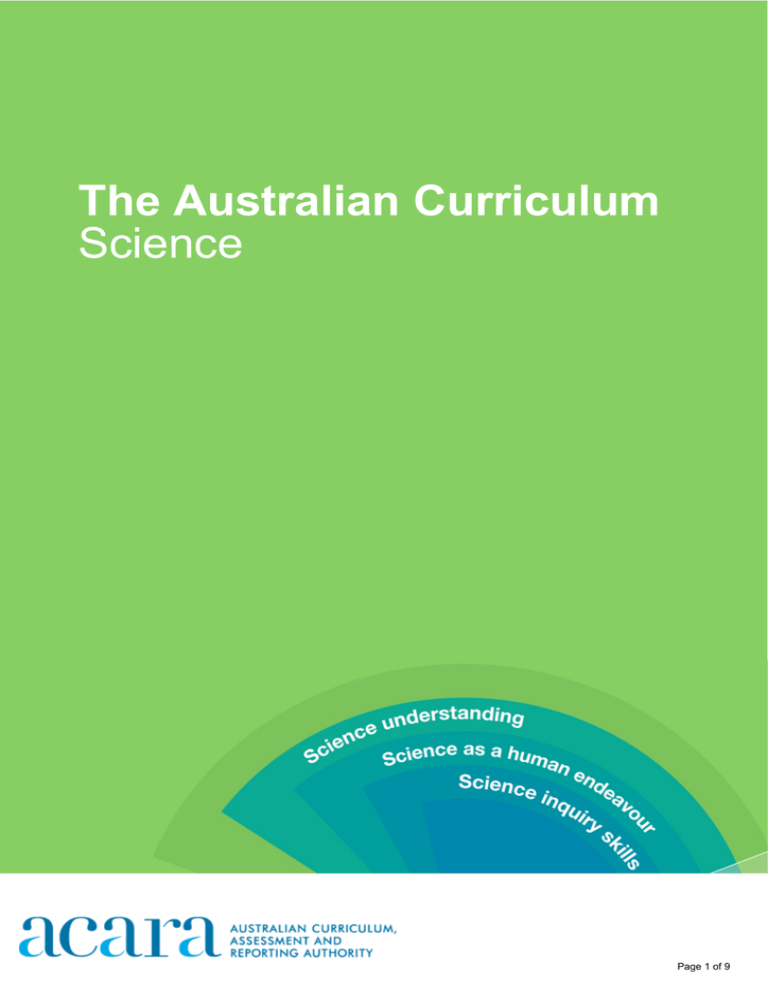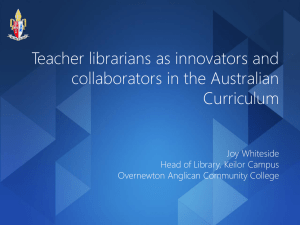Achievement Standards in Science
advertisement

The Australian Curriculum Science Page 1 of 9 Science Foundation Year Achievement Standard By the end of the Foundation year, students describe the properties and behaviour of familiar objects. They suggest how the environment affects them and other living things. Students share observations of familiar objects and events. ACARA | The Australian Curriculum | Version 6.0 dated Tuesday, 18 February 2014 The Australian Curriculum is licensed under Creative Commons. For more information see http://www.australiancurriculum.edu.au/copyright Page 2 of 9 Science Year 1 Achievement Standard By the end of Year 1, students describe objects and events that they encounter in their everyday lives, and the effects of interacting with materials and objects. They identify a range of habitats. They describe changes to things in their local environment and suggest how science helps people care for environments. Students make predictions, and investigate everyday phenomena. They follow instructions to record and sort their observations and share their observations with others. ACARA | The Australian Curriculum | Version 6.0 dated Tuesday, 18 February 2014 The Australian Curriculum is licensed under Creative Commons. For more information see http://www.australiancurriculum.edu.au/copyright Page 3 of 9 Science Year 2 Achievement Standard By the end of Year 2, students describe changes to objects, materials and living things. They identify that certain materials and resources have different uses and describe examples of where science is used in people’s daily lives. Students pose questions about their experiences and predict outcomes of investigations. They use informal measurements to make and compare observations. They follow instructions to record and represent their observations and communicate their ideas to others. ACARA | The Australian Curriculum | Version 6.0 dated Tuesday, 18 February 2014 The Australian Curriculum is licensed under Creative Commons. For more information see http://www.australiancurriculum.edu.au/copyright Page 4 of 9 Science Year 3 Achievement Standard By the end of Year 3, students use their understanding of the movement of the Earth, materials and the behaviour of heat to suggest explanations for everyday observations They describe features common to living things. They describe how they can use science investigations to respond to questions and identify where people use science knowledge in their lives. Students use their experiences to pose questions and predict the outcomes of investigations. They make formal measurements and follow procedures to collect and present observations in a way that helps to answer the investigation questions. Students suggest possible reasons for their findings. They describe how safety and fairness were considered in their investigations. They use diagrams and other representations to communicate their ideas. ACARA | The Australian Curriculum | Version 6.0 dated Tuesday, 18 February 2014 The Australian Curriculum is licensed under Creative Commons. For more information see http://www.australiancurriculum.edu.au/copyright Page 5 of 9 Science Year 4 Achievement Standard By the end of Year 4, students apply the observable properties of materials to explain how objects and materials can be used. They use contact and non-contact forces to describe interactions between objects. They discuss how natural and human processes cause changes to the Earth’s surface. They describe relationships that assist the survival of living things and sequence key stages in the life cycle of a plant or animal. They identify when science is used to ask questions and make predictions. They describe situations where science understanding can influence their own and others’ actions. Students follow instructions to identify investigable questions about familiar contexts and predict likely outcomes from investigations. They discuss ways to conduct investigations and safely use equipment to make and record observations. They use provided tables and simple column graphs to organise their data and identify patterns in data. Students suggest explanations for observations and compare their findings with their predictions. They suggest reasons why their methods were fair or not. They complete simple reports to communicate their methods and findings. ACARA | The Australian Curriculum | Version 6.0 dated Tuesday, 18 February 2014 The Australian Curriculum is licensed under Creative Commons. For more information see http://www.australiancurriculum.edu.au/copyright Page 6 of 9 Science Year 5 Achievement Standard By the end of Year 5, students classify substances according to their observable properties and behaviours. They explain everyday phenomena associated with the transfer of light. They describe the key features of our solar system. They analyse how the form of living things enables them to function in their environments. Students discuss how scientific developments have affected people’s lives and how science knowledge develops from many people’s contributions. Students follow instructions to pose questions for investigation, predict what might happen when variables are changed, and plan investigation methods. They use equipment in ways that are safe and improve the accuracy of their observations. Students construct tables and graphs to organise data and identify patterns. They use patterns in their data to suggest explanations and refer to data when they report findings. They describe ways to improve the fairness of their methods and communicate their ideas, methods and findings using a range of text types. ACARA | The Australian Curriculum | Version 6.0 dated Tuesday, 18 February 2014 The Australian Curriculum is licensed under Creative Commons. For more information see http://www.australiancurriculum.edu.au/copyright Page 7 of 9 Science Year 6 Achievement Standard By the end of Year 6, students compare and classify different types of observable changes to materials. They analyse requirements for the transfer of electricity and describe how energy can be transformed from one form to another to generate electricity. They explain how natural events cause rapid change to the Earth’s surface. They describe and predict the effect of environmental changes on individual living things. Students explain how scientific knowledge is used in decision making and identify contributions to the development of science by people from a range of cultures. Students follow procedures to develop investigable questions and design investigations into simple cause-and-effect relationships. They identify variables to be changed and measured and describe potential safety risks when planning methods. They collect, organise and interpret their data, identifying where improvements to their methods or research could improve the data. They describe and analyse relationships in data using graphic representations and construct multi-modal texts to communicate ideas, methods and findings. ACARA | The Australian Curriculum | Version 6.0 dated Tuesday, 18 February 2014 The Australian Curriculum is licensed under Creative Commons. For more information see http://www.australiancurriculum.edu.au/copyright Page 8 of 9 Science Year 7 Achievement Standard By the end of Year 7, students describe techniques to separate pure substances from mixtures. They represent and predict the effects of unbalanced forces, including Earth’s gravity, on motion. They explain how the relative positions of the Earth, sun and moon affect phenomena on Earth. They analyse how the sustainable use of resources depends on the way they are formed and cycle through Earth systems. They predict the effect of environmental changes on feeding relationships and classify and organise diverse organisms based on observable differences. Students describe situations where scientific knowledge from different science disciplines has been used to solve a real-world problem. They explain how the solution was viewed by, and impacted on, different groups in society. Students identify questions that can be investigated scientifically. They plan fair experimental methods, identifying variables to be changed and measured. They select equipment that improves fairness and accuracy and describe how they considered safety. Students draw on evidence to support their conclusions. They summarise data from different sources, describe trends and refer to the quality of their data when suggesting improvements to their methods. They communicate their ideas, methods and findings using scientific language and appropriate representations. ACARA | The Australian Curriculum | Version 6.0 dated Tuesday, 18 February 2014 The Australian Curriculum is licensed under Creative Commons. For more information see http://www.australiancurriculum.edu.au/copyright Page 9 of 9

